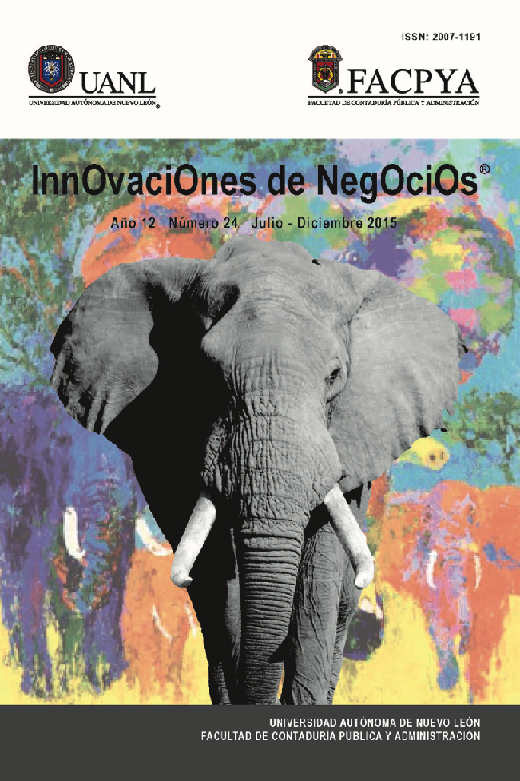Reduction and control of costs in manufacturing company with Six Sigma
DOI:
https://doi.org/10.29105/rinn12.24-3Keywords:
process entitlement, quality control, scrap, six sigma, wasteAbstract
This case study indicates how the statistics and engineering analysis Six Sigma lead us to find the root-cause operational solutions, resulting on improvement in quality and control of our processes. After defining the real root-cause problem and proving them statistically, it shows us how we can control and improve operations by eliminating waste and generating annual savings in this empirical research, reducing 40% of the use of coatings generating savings greater than $1,000,000.00 MN.
Downloads
References
Acuña, J. (2003). Ingeniería de confiabilidad. Cartago: Tecnológica de Costa Rica.
Adams, C. Gupta, P. & Wilson, C. (2003). Six sigma deployment. Burlington: ButterworthHeinemann.
Alonso, A. (2003). Análisis en los defectos de un simulador. Madrid: Departamento de ingeniería de la Universidad de Madrid.
Antony, J. y Bañuelas, R. (2002). Key ingredients for the effective implementation of six sigma program. Measuring Business Excellence, 6(4), 20-27.
Breyfogle, F.W. III. (1999). Implementing six sigma: Smarter solutions using statistical methods. New York: John Wiley & Sons.
Cassettari, C., Batocchio, A., & Marcondes, A., (2005). Lean manufacturing and six sigma, SAE Technical Paper, 2005-01-4047, 1-11.
Carot, V. (1998). Control estadístico de calidad. Valencia: Servicios de publicaciones Universidad Politécnica de Valencia
Dennis, P. (2002). Lean production simplified. New York: Productivity Press.
Dreachslin J. & Peggy D. (2007). Applying six sigma and DMAIC to diversity initiatives, Journal of healthcare management, 52(6), 361-367.
Evans, J. R. (2008). Adminstración y control de la calidad. Cd. de México: CENGAGE.
Escalante, E. (2008). Seis sigma, metodología y técnicas. Cd. de México: Limusa.
Garza V, J. B (2013). Aplicación de diseño de experimentos para el análisis de secado de un producto, Innovaciones de Negocios, 10(19), 145-158.
Ginn, D. (2004). The desing for six sigma. Methuen: GOAL/QPC.
Gutierrez, H. (2009). Control estadístico de la calidad y seis sigma. Guadalajara: McGraw Gill.
Harry, M.J. & Schroeder, R. (1999). Six sigma: The breakthrough management strategy revolutionizing the world´s top corporations. New York: Doubleday.
Hasanah I. S; Hermana B. & Hastiyani H. (2007). Application of six sigma method using DMAIC method on string production, Proceedings of the International Seminar on Industrial Engineering and Management, J24-29.
Herrscher, E. (2010). El valor sistémico de las organizaciones. Cd. de México: Granica.
Hoerl, R. W. (1998). Six sigma and the future of the quality profession, Quality Progress, 31(6), 35-38.
Hoerl, R. W. (2001). Six sigma black belts: what do the need to know?, Journal of Quality Technology, 33(4), 391-406.
Juran, J. (1990). Juran y el liderazgo para la calidad. Madrid: Díaz de Santos.
Lynch D., Bertolino S. & Cloutier, E. (2003). How to scope DMAIC projects, Quality Progress, 36(1), 37-44.
Martínez, M. & Garza, J. B. (2012). Reducción de costos asociados a los desperdicios de un producto perteneciente a una empresa manufacturera, Innovaciones de Negocios, 10(20), 197-219.
Meier, J. L. (2006). The Toyota way fieldbook. New York: McGraw Hill.
Montgomery, D. C. (2004). Diseño y análisis de experimentos. México: Limusa Wiley.
Keller, P. A. (2001). Six sigma deployment, Tucson: Quality Publishing.
Pande, P. Neuman, R. & Cavanagh, R. (2001). The six sigma way. New York: Mc Graw Hill.
Pyzdek, T. (2014). The six sigma handbook: A complete guide for greenbelts, blackbelts and managers at all levels. New York: Mc Graw Hill.
Salafranca, L. (2005). Análisis estadístico mediante aplicaciones informáticas: SPSS,
Stratgraphics, Minitab y Excel. Barcelona: Gráficas Rey.
Sánchez, G. (2009). Medición del ruido en la línea de transmisión eléctrica generado por electrodomésticos, para aplicaciones de PLC. Tesis para obtener el título de Licenciado en Ingeniería en Electrónica y Comunicaciones por la Universidad de
las Américas Puebla, Escuela de Ingeniería.
Snee, R. (1999). Why should statisticians pay attentiion to six sigma?, Quality Progress, 32(9), 100-103.
Snee, R. (2003). Leading six sigma. Nueva Jersey: Pearson.
Sokovic M., Pavletic D. & Kern K. (2010). Quality Improvement Methodologies PDCA, Cycle, RADAR Matrix, DMAIC and DFSS, Journal of Achievements in Materials and Manufacturing Engineering, 43(1), 476-483.
Tanco M., Viles E. & Pozueta L. (2009). Comparing different approaches for design of experiments (DoE). In Gelman, Len (Ed.), Advances in electrical engineering and computational science, Dordrecht: Springer, 611-622.
Terradez M,. & Juan, A. (2002) Análisis de Variables (Anova) Proyecto e-Math 18. Financiado por la Secretaría de Estado de Educación y Universidades (MECD)
Tolamatl, J., Gallardo, D., Varela, J. & Ávila E. (2011). Aplicación de seis sigma en una microempresa del ramo automotriz, Conciencia Tecnológica, 42, 11-18.
Tovar, A. (2007). CPIMC Un modelo de administración por procesos. Cd. de México: Panorama Editorial.
Womack, J. & Jones, D.T. (1996). Lean thinking: Banish waste and create wealth in your corporation. London: Simon and Shustecer.
Downloads
Published
How to Cite
Issue
Section
License
Copyright (c) 2017 Innovaciones de Negocios

This work is licensed under a Creative Commons Attribution-NonCommercial-ShareAlike 4.0 International License.
The InnOvaciOnes de NegOciOs magazine is a free and open access electronic magazine of a scientific-academic nature and is a publication of the Autonomous University of Nuevo León, in which the authors retain their copyright and grant the magazine the exclusive right to first publication of the work. Third parties are allowed to use the published content, as long as the authorship of the work is acknowledged and the first publication in this journal is cited.
For more information, please contact the Research Secretary (FACPyA) of the Autonomous University of Nuevo León. Telephone: (81) 1340-4430. Email: revinnova@uanl.mx










